Friction Behavior of Ceramic Materials for the Development of Bridge-Bearing Friction Materials
Abstract
Featured Application
Abstract
1. Introduction
2. Properties of Ceramics
3. Friction Test Results and Analysis of Ceramic Materials
3.1. Friction Test Plan for Ceramic Materials
3.2. Frictional Behavior of Ceramic Materials
3.3. Long-Term Durability Evaluation of Ceramic Materials
4. Test Results and Analysis of Bridge Bearings with Ceramic Applications
4.1. Test Plan for Bridge Bearings
4.2. Compression Test Results of Bridge Bearings by Friction Material
5. Conclusions
- During the friction tests of ceramic materials under a contact pressure of 15 MPa, the friction behavior differed between roughness coefficients of 0.8 and 0.027; however, the average COF was 0.16 in both cases, indicating a minimal influence of surface roughness. This suggests that the high strength and hardness of ceramic materials, combined with strong surface contact under high-load conditions, minimize the microscale effects of surface roughness and amplify the inherent COF of the ceramics.
- Under both normal and extreme compressive loads corresponding to a 3000 kN bridge-bearing capacity, the ceramic-friction material exhibited ideal compressive behavior during both the loading and unloading phases, demonstrating excellent compressive-stress performance.
- During the friction tests of bridge bearings with ceramic-friction materials, the COF gradually increased with the number of friction cycles; however, the rate of increase diminished over time, eventually converging toward an average value of 0.16. This indicates that ceramic materials can maintain a stable frictional performance with minimal fluctuation.
- Ceramic materials demonstrated excellent wear resistance and durability without defects or damage, even under high compressive loads and repeated horizontal friction. This consistent friction performance suggests that ceramics are advantageous for use as bridge-bearing friction materials and offer benefits in terms of durability, maintenance, and installation.
- Although the COF required for fluoropolymer-based friction materials in bridge bearings is less than 0.05, the ceramic-friction materials do not satisfy this threshold. However, the unique physical and chemical properties of ceramics, along with their superior mechanical characteristics and COF of approximately 0.16, suggest their potential applications in energy dissipation mechanisms, extremely low- and high-temperature environments, and situations where the use of metallic components is restricted.
Author Contributions
Funding
Institutional Review Board Statement
Informed Consent Statement
Data Availability Statement
Conflicts of Interest
References
- Lee, Y.I.; Lee, Y.J.; Lee, H.P.; Cho, M.S.; Jee, Y.S.; Beak, J.H. Study on the performance improvement of an EQS device applied nuclear power plant. J. Earthq. Eng. Soc. Korea 2015, 19, 13–19. (In Korean) [Google Scholar] [CrossRef]
- Joh, C.; Yoon, H.; Kim, Y.J. Accumulated Sliding Distance of the Sliding Element in the Bridge Bearing; Korean Society of Civil Engineers: Seoul, Republic of Korea, 2006; pp. 1320–1323. [Google Scholar]
- Choi, E.; Choi, Y.; Lee, J.; Jang, Y.; Lee, S. Assessment of friction of ep frictional materials used for spherical bearings of railway bridges. J. Korean Soc. Steel Constr. 2019, 31, 293–299. (In Korean) [Google Scholar] [CrossRef]
- Kang, D.H.; Hyun, J.H. Evaluation of the durability of spherical bridge bearing using polyamide engineering plastic middle plate. J. Korean Soc. Railw. 2021, 9, 1021–1031. (In Korean) [Google Scholar] [CrossRef]
- Nosov, Y.O.; Kamenskikh, A.A. Influence Analysis of Lubricant Recesses on the Working Capacity of the Bridge Span Spherical Bearing. Lubricants 2022, 10, 283. [Google Scholar] [CrossRef]
- Dong, S.; Chung, K.H.; Lee, K.S. Effect of surface roughness of counterface on tribological characteristics of PTFE and UHMWPE. Tribol. Lubr. 2011, 27, 293–301. [Google Scholar] [CrossRef][Green Version]
- Kamenskih, A.A.; Trufanov, N.A. Numerical analysis of the stress state of a spherical contact system with an interlayer of antifriction material. Comput. Contin. Mech. 2013, 6, 54–61. [Google Scholar] [CrossRef]
- Pavlenko, V.I.; Bondarenko, G.G.; Tarasov, D.G.; Edamenko, O.D. Gamma modification of radiation-resistant fluoroplastic composite. Inorg. Mater. Appl. Res. 2013, 4, 389–393. [Google Scholar] [CrossRef]
- Han, O.; Kwark, J.W.; Lee, J.W.; Han, W.J. Analytical Study on the Frictional Behavior of Sliding Surfaces Depending on Ceramic Friction Materials. Appl. Sci. 2023, 13, 234. [Google Scholar] [CrossRef]
- Oh, S.T.; Lee, D.J.; Yeon, J.S.; Lee, H.J.; Jeong, S.H. Dynamic Behaviors of Bearings of the Two-Span Continuous PSC Box Bridge with 40 m Span for KTX Vehicle. In Proceedings of the 25th Annual Conference, KSR2013A032, Daegu, Republic of Korea, 17 July 2023; The Korean Society for Railway: Daegu, Republic of Korea, 2013; pp. 130–132. [Google Scholar]
- Oh, S.T.; Lee, D.J.; Jun, S.M.; Jeong, S.H. A long-term friction test of bridge bearings considering running speed of next generation train. J. Korea Inst. Struct. Maint. Insp. 2016, 20, 34–39. (In Korean) [Google Scholar]
- Wang, H.; Sun, A.; Qi, X.; Dong, Y.; Fan, B. Experimental and analytical investigations on tribological properties of PTFE/AP composites. Polymers 2021, 13, 4295. [Google Scholar] [CrossRef]
- Mnif, R.; Ben Jemaa, M.C.; Kacem, N.H.; Elleuch, R. Impact of viscoelasticity on the tribological behavior of PTFE composites for valve seals application. Tribol. Trans. 2013, 56, 879–886. [Google Scholar] [CrossRef]
- Zhang, Y.; Xu, S.; Zhang, Q.; Zhou, Y. Experimental and theoretical research on the stress-relaxation behaviors of PTFE coated fabrics under different temperatures. Adv. Mater. Sci. Eng. 2015, 2015, 319473. [Google Scholar] [CrossRef]
- Feng, C.; Zhang, D.; Chen, K. In situ microscopic observations of dynamic viscoelastic contact and deformation at a friction interface. Mater. Express 2019, 9, 235–244. [Google Scholar] [CrossRef]
- Oh, J.; Jang, C.; Kim, J.H. A study on the characteristics of bridge bearings behavior by finite element analysis and model test. J. Vibroengineering 2015, 17, 2559–2571. [Google Scholar]
- Kim, S.J.; Kim, J.S.; Han, T.S. Performance Analysis of Friction Pendulum System using PVDF/MgO Friction Material. J. Comput. Struct. Eng. Inst. Korea 2021, 34, 213–219. (In Korean) [Google Scholar] [CrossRef]
- Choi, J.Y.; Park, H.S.; Chung, J.S. Evaluation on Fatigue Behavior of EP (Engineering Plastic) Friction Pendulum Bearing System. J. Converg. Cult. Technol. 2020, 6, 703–708. (In Korean) [Google Scholar]
- Adamov, A.A.; Kamenskikh, A.A. The Deformation Behavior of Modern Antifriction Polymer Materials in the Elements of Transport and Logistics Systems with Frictional Contact. In Digital Science 2019; Springer International Publishing: Berlin/Heidelberg, Germany, 2019; Volume 1114, pp. 522–532. [Google Scholar]
- Quaglini, V.; Bocciarelli, M.; Gandelli, E.; Dubini, P. Numerical assessment of frictional heating in sliding bearings for seismic isolation. J. Earthq. Eng. 2014, 18, 1198–1216. [Google Scholar] [CrossRef]
- Yang, Y.; Zhang, Y.; Ju, J. Study on the mechanical properties of a type of spherical bearing. J. Theor. Appl. Mech. 2021, 59, 539–550. [Google Scholar] [CrossRef]
- Adamov, A.A.; Kamenskikh, A.A.; Pankova, A.P. Influence analysis of the antifriction layer materials and thickness on the contact interaction of spherical bearings elements. Lubricants 2022, 10, 30. [Google Scholar] [CrossRef]
- Wei, W.; Yuan, Y.; Igarashi, A.; Zhu, H.; Luo, K. Generalized hyper-viscoelastic modeling and experimental characterization of unfilled and carbon black filled natural rubber for civil structural applications. Constr. Build. Mater. 2020, 253, 119211. [Google Scholar] [CrossRef]
- Lee, K.H.; Park, D.B.; Jang, K.S.; Sim, K.C.; Choi, J.S. Evaluate the Friction Coefficient of Friction Pendulum Bearing Applied New Friction Material; Korean Society of Civil Engineers: Seoul, Republic of Korea, 2017; pp. 1353–1354. [Google Scholar]
- Boch, P.; Ni, J.C. Ceramic Materials: Processes, Properties, and Applications, 98; John Wiley & Sons: Hoboken, NJ, USA, 2010. [Google Scholar]
- Xing, Y.; Deng, J.; Wu, Z.; Wu, F. High friction and low wear properties of laser-textured ceramic surface under dry friction. Opt. Laser Technol. 2017, 93, 24–32. [Google Scholar] [CrossRef]
- Singh, V.; Pandey, P.K. Advancement of ceramic bearings and its applications. Int. J. Emerg. Technol. Innov. Res. 2018, 5, 440–446. [Google Scholar]
- Huang, Y.; Wan, C. Controllable fabrication and multifunctional applications of graphene/ceramic composites. J. Adv. Ceram. 2020, 9, 271–291. [Google Scholar] [CrossRef]
- Zhou, B.Y.; Fan, S.J.; Fan, Y.C.; Zheng, Q.I.; Zhang, X.; Jiang, W.; Wang, L.J. Recent progress in ceramic matrix composites reinforced with graphene nanoplatelets. Rare Met. 2020, 39, 513–528. [Google Scholar] [CrossRef]
- Mustafa, T.; Khan, S.U.; Khan, M.N.; Amin, M. Recent progress in graphene-reinforced biomimetic ceramic composites: A review. J. Korean Ceram. Soc. 2024, 1–21. [Google Scholar] [CrossRef]
- AASHTO. Bridge Design Specifications; American Association of State Highway and Transportation Officials: Washington, DC, USA, 2010. [Google Scholar]
- Frantsen, J.E.; Mathiesen, T. Specifying Stainless Steel Surfaces for the Brewery, Dairy and Pharmaceutical Sectors; Nace Corrosion: Houston, TX, USA, 2009; p. 9573. [Google Scholar]
- Korea Highway Bridge Specifications; Korean Ministry of Construction and Transportation: Sejong, Republic of Korea, 2016.
- Standard PN-EN ISO 4288; Geometrical Product Specifications (GPS)–Surface Texture: Profile Method–Rules and Procedures for the Assessment of Surface Texture. ISO: Geneva, Switzerland, 1997.
- Denape, J.; Lamon, J. Sliding friction of ceramics: Mechanical action of the wear debris. J. Mater. Sci. 1990, 25, 3592–3604. [Google Scholar] [CrossRef]
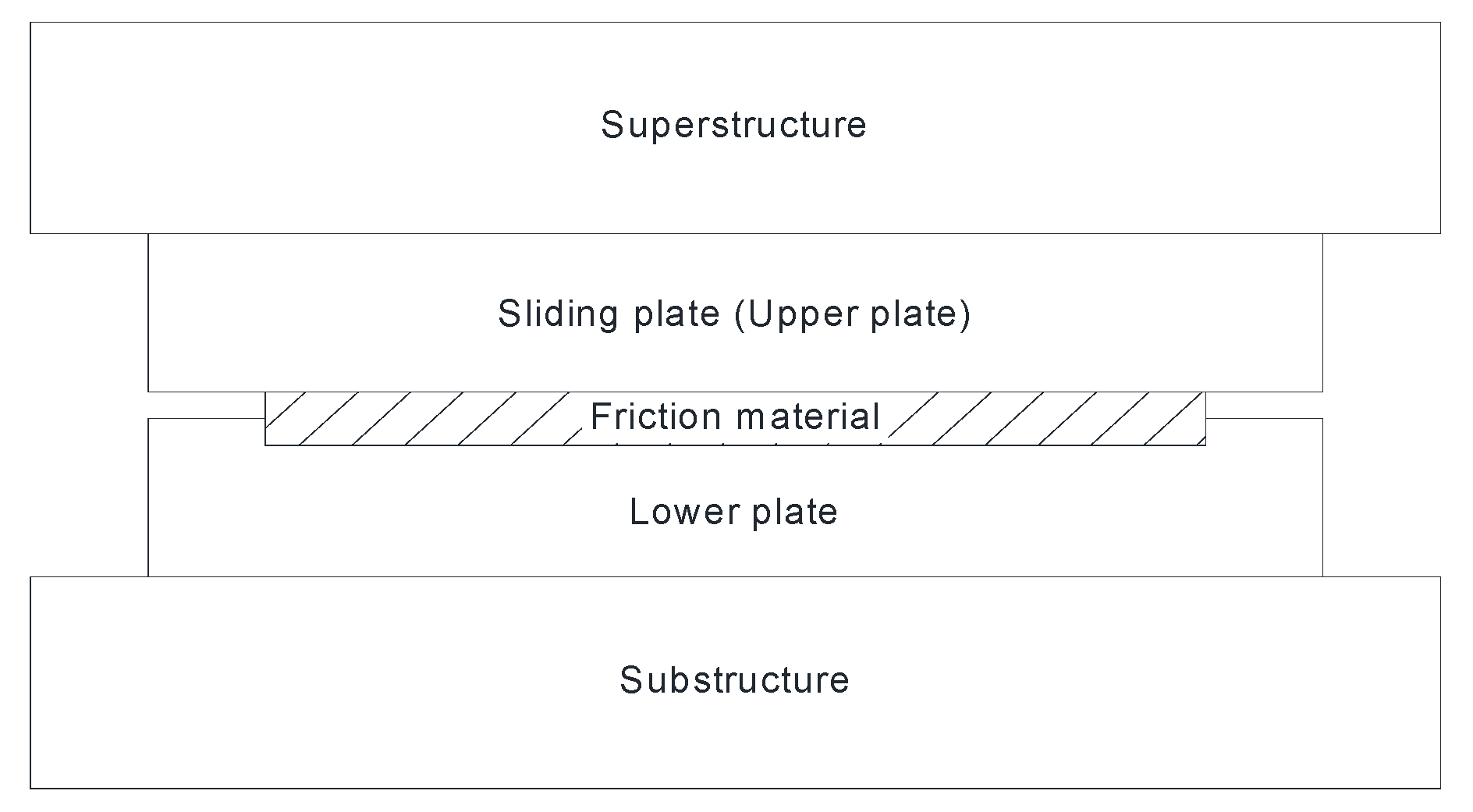
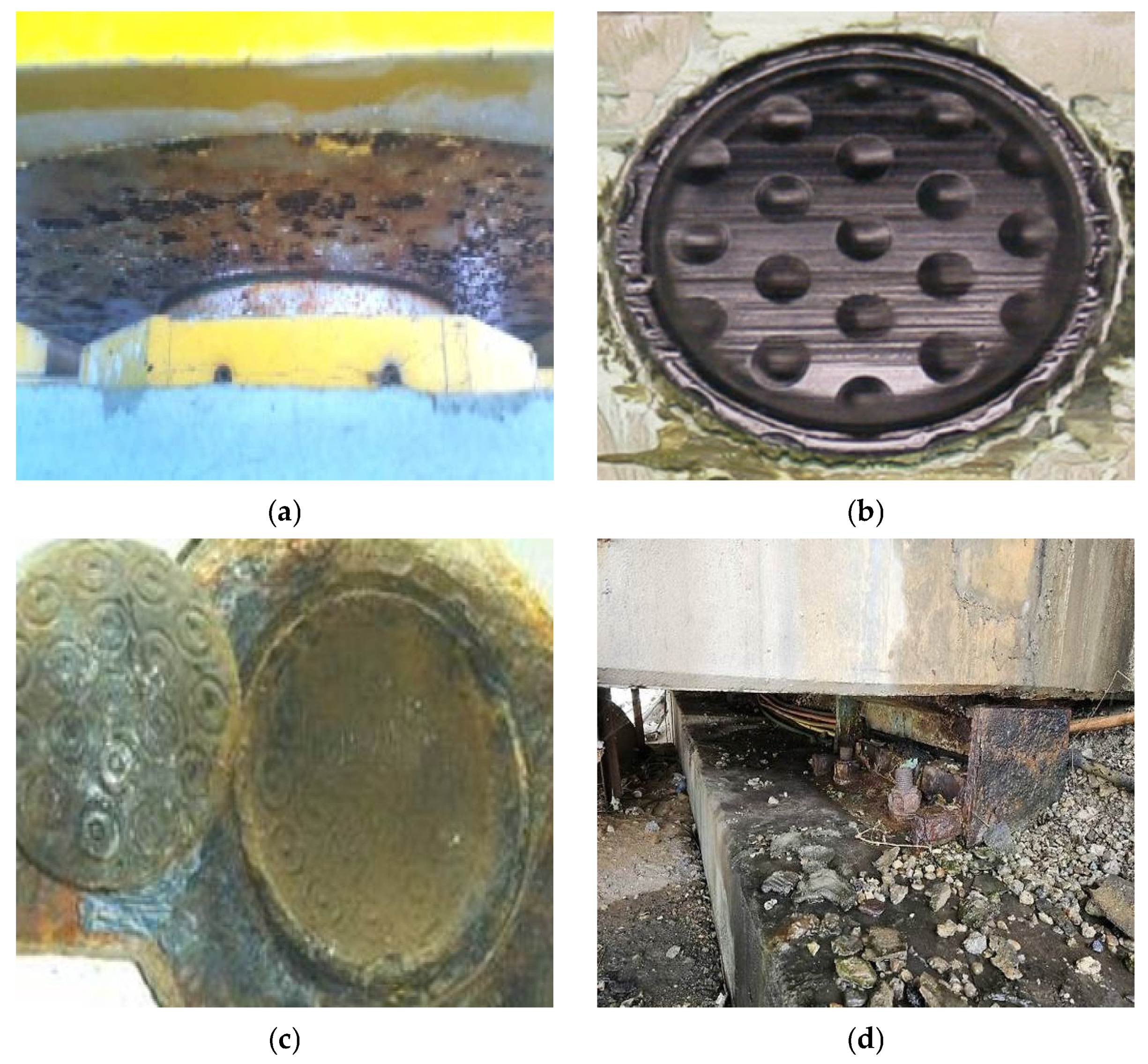


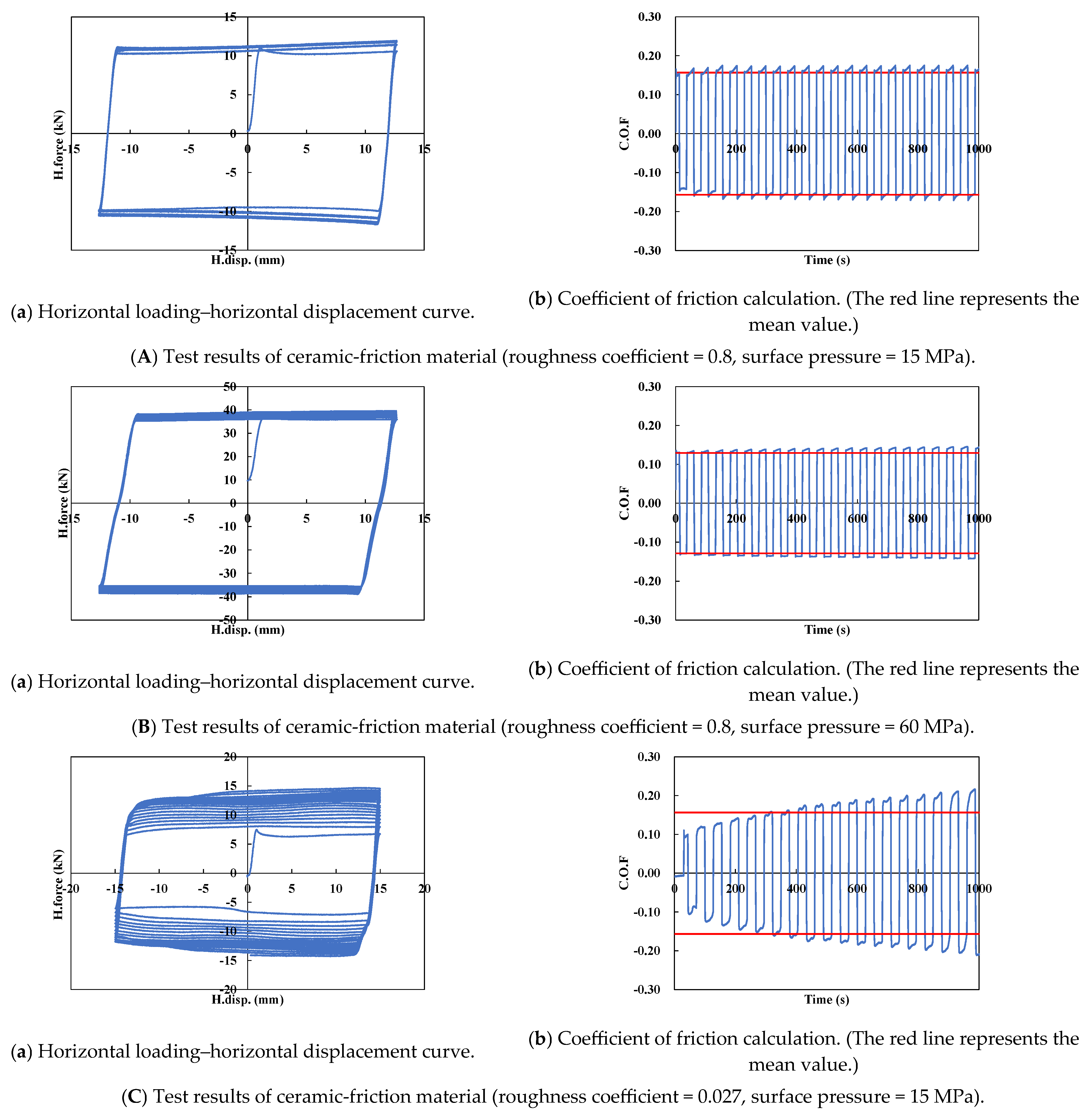

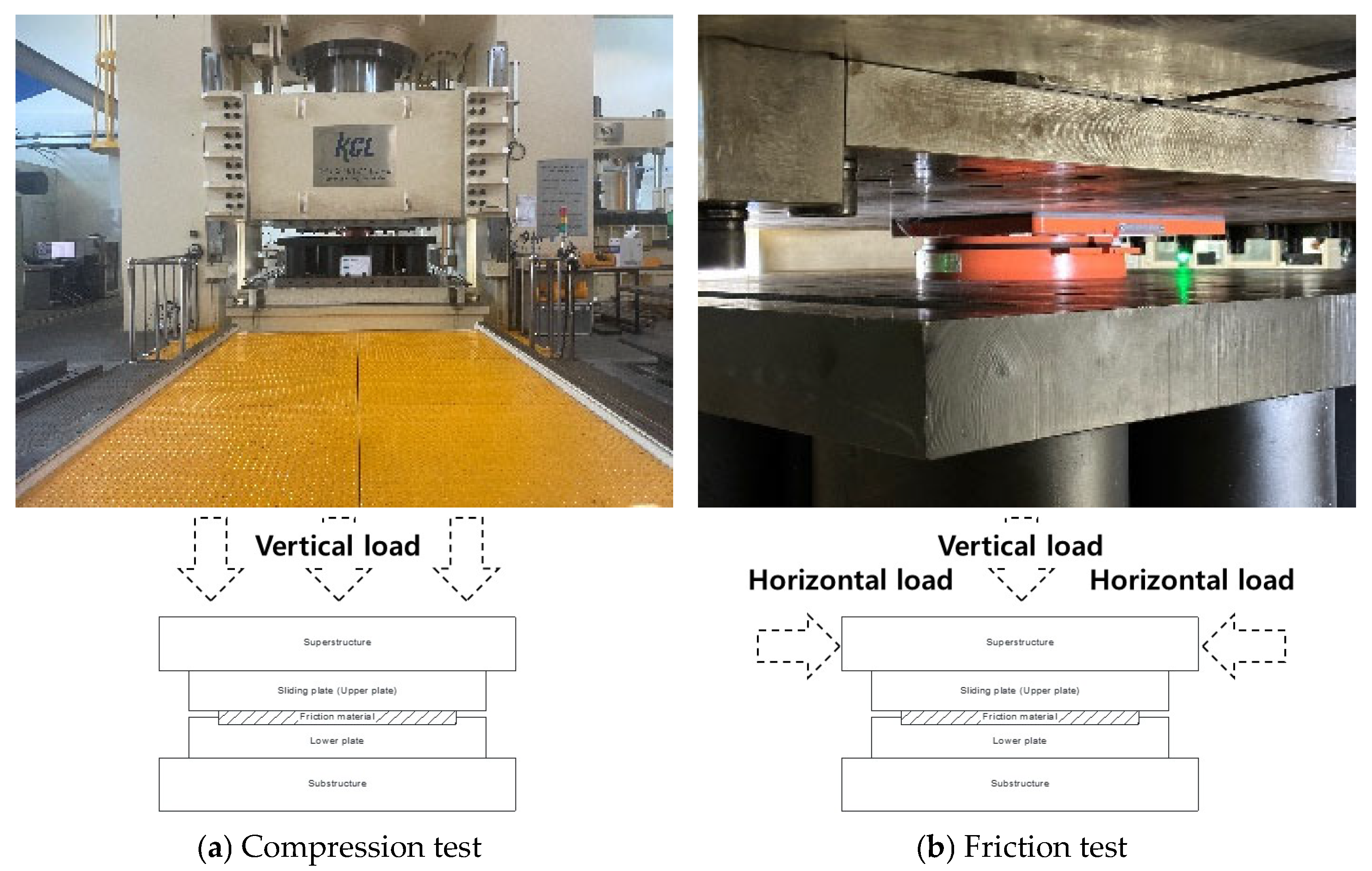
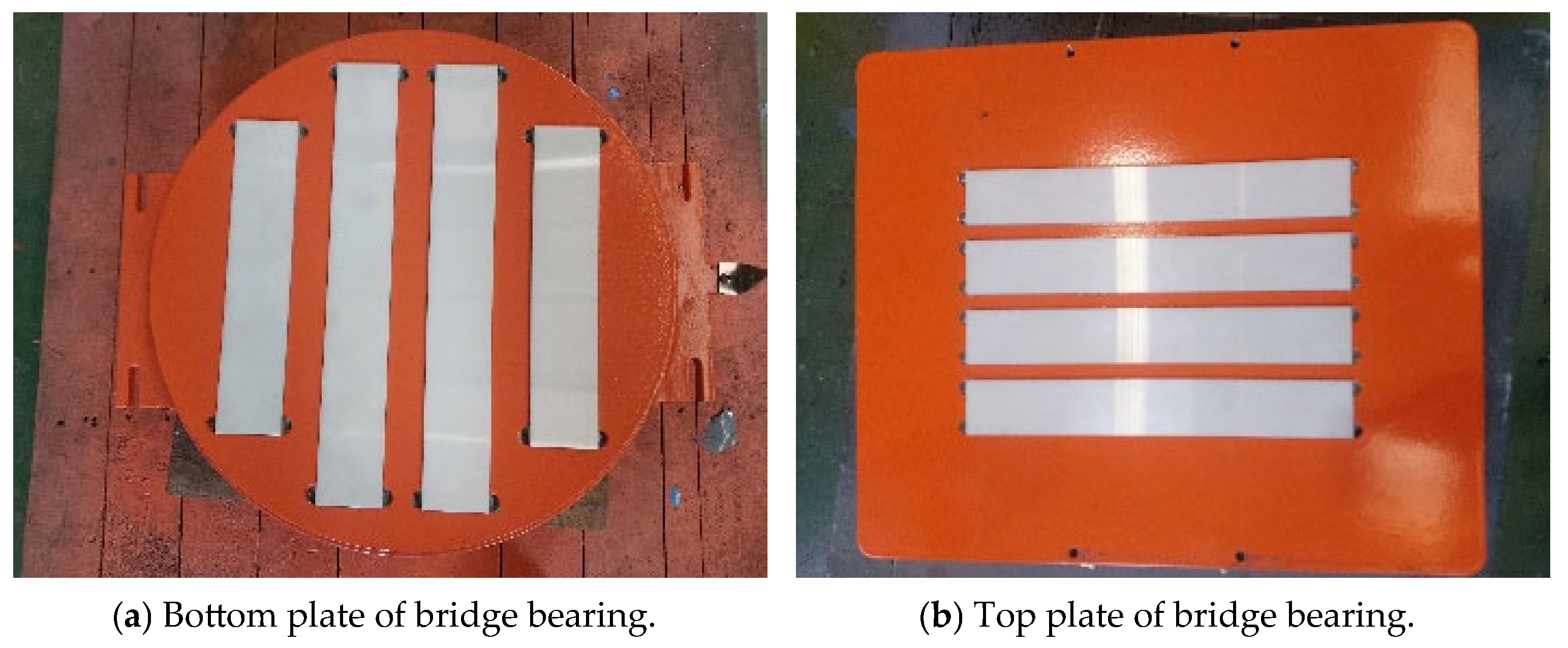
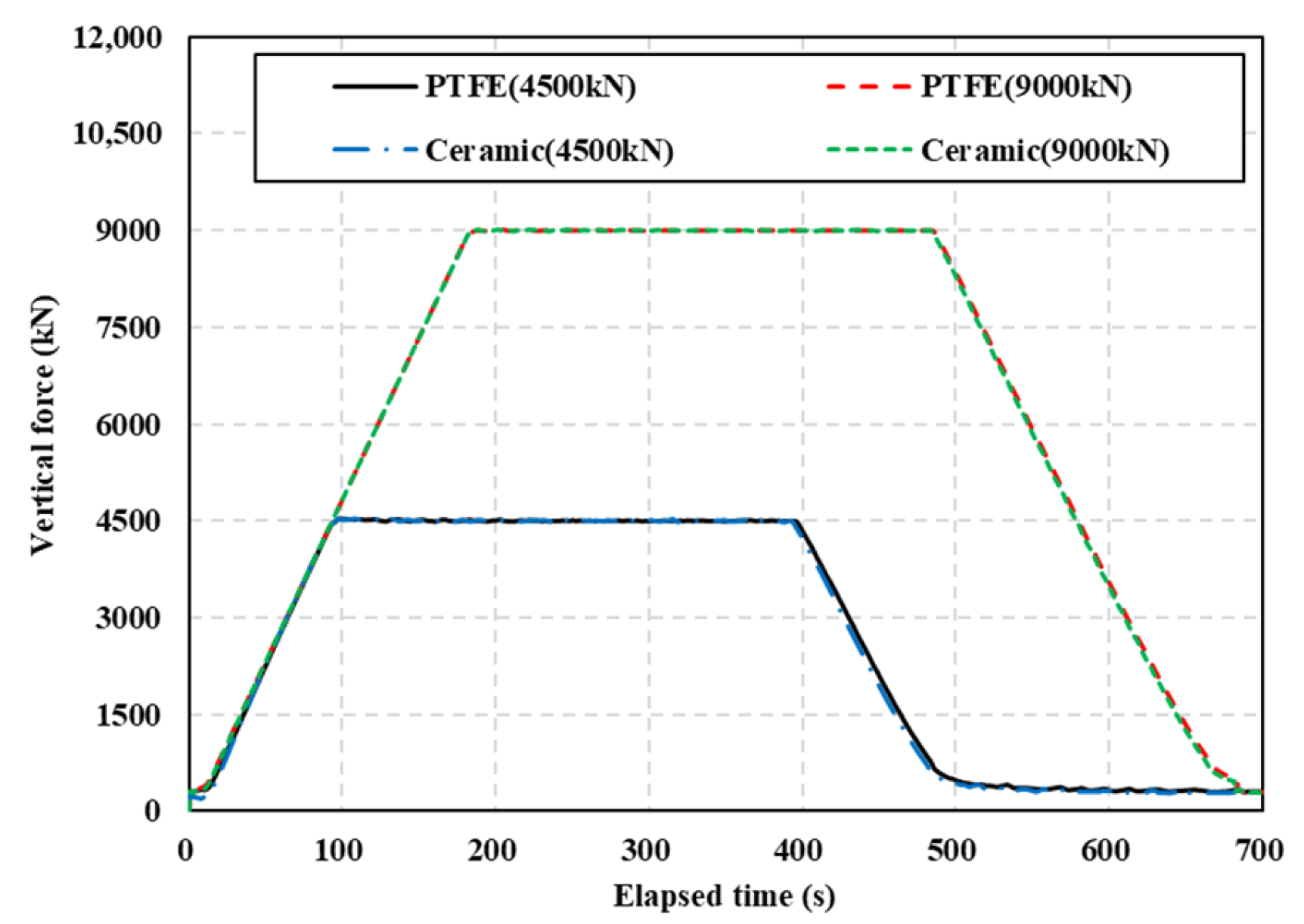
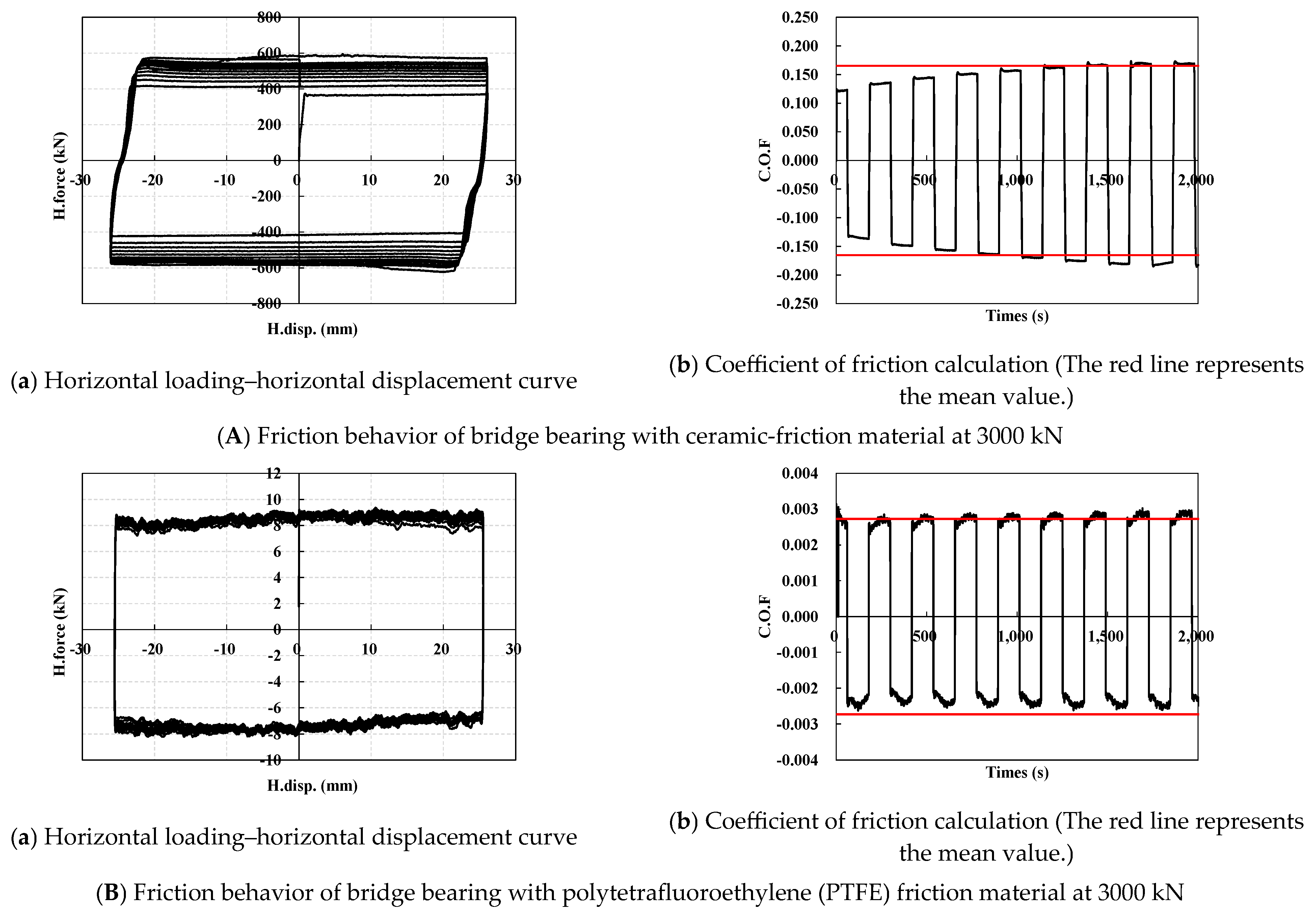
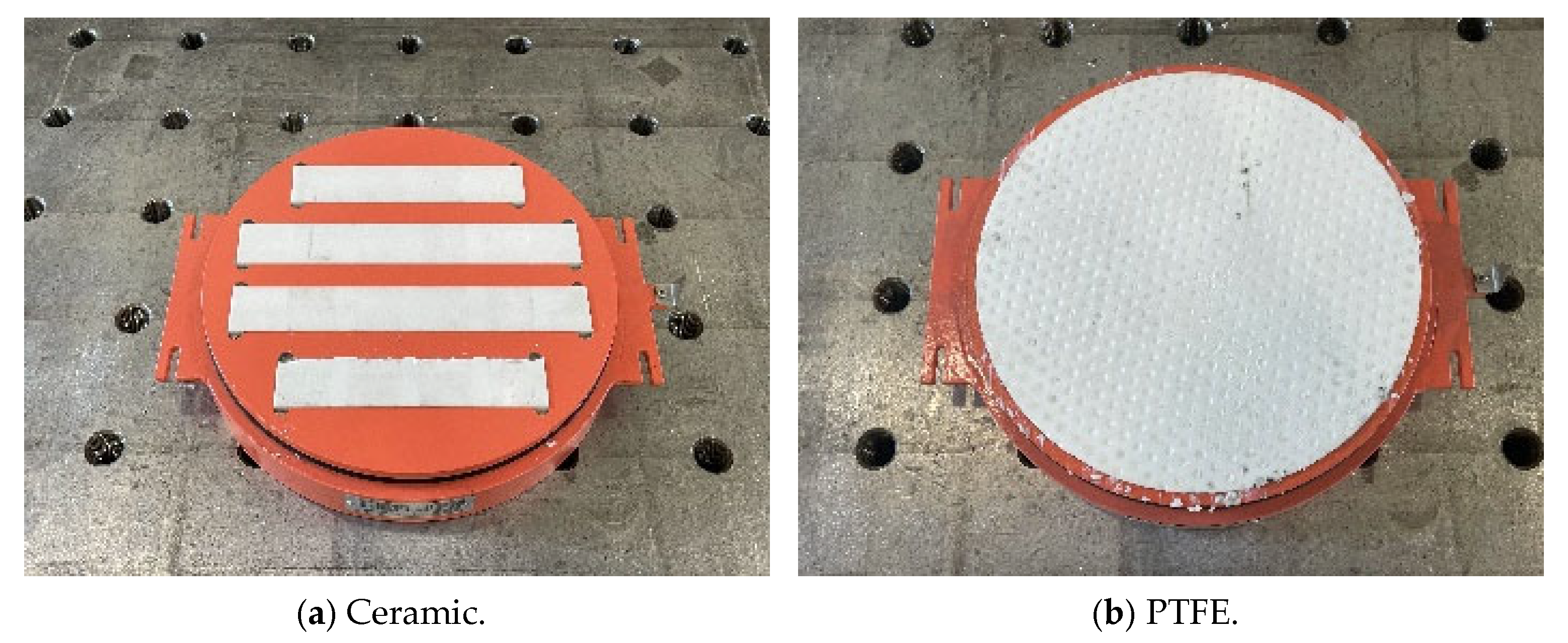
| Properties | Ceramic (ZrO2) | Stainless Steel | PTFE | EP | UHMWPE |
|---|---|---|---|---|---|
| Young’s modulus (GPa) | 220 | 210 | 0.41 | 1.3 | 31 |
| Flexural strength (MPa) | 1000 | 515 | 500 | 70~80 | 600 |
| Hardness (HV) | 1550 | 500 | - | - | - |
| Component | Result (%) |
|---|---|
| ZrO2 | 94.66 |
| Y2O3 | 5.34 |
| Al2O3 | 0.23 |
| Fe2O3 | 0.001 |
| TiO3 | 0.001 |
| SiO3 | 0.004 |
| CaO | 0.001 |
| Na2O | 0.003 |
Disclaimer/Publisher’s Note: The statements, opinions and data contained in all publications are solely those of the individual author(s) and contributor(s) and not of MDPI and/or the editor(s). MDPI and/or the editor(s) disclaim responsibility for any injury to people or property resulting from any ideas, methods, instructions or products referred to in the content. |
© 2024 by the authors. Licensee MDPI, Basel, Switzerland. This article is an open access article distributed under the terms and conditions of the Creative Commons Attribution (CC BY) license (https://creativecommons.org/licenses/by/4.0/).
Share and Cite
Park, J.-H.; Lee, J.-W. Friction Behavior of Ceramic Materials for the Development of Bridge-Bearing Friction Materials. Appl. Sci. 2025, 15, 152. https://doi.org/10.3390/app15010152
Park J-H, Lee J-W. Friction Behavior of Ceramic Materials for the Development of Bridge-Bearing Friction Materials. Applied Sciences. 2025; 15(1):152. https://doi.org/10.3390/app15010152
Chicago/Turabian StylePark, Ji-Hun, and Jung-Woo Lee. 2025. "Friction Behavior of Ceramic Materials for the Development of Bridge-Bearing Friction Materials" Applied Sciences 15, no. 1: 152. https://doi.org/10.3390/app15010152
APA StylePark, J.-H., & Lee, J.-W. (2025). Friction Behavior of Ceramic Materials for the Development of Bridge-Bearing Friction Materials. Applied Sciences, 15(1), 152. https://doi.org/10.3390/app15010152






